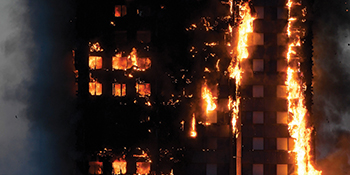Planning is key to safety in tall structures
TOM BAINES* of Arcadis, who will be speaking at the Safety Design in Buildings conferences in Saudi Arabia next month (April), highlights the importance of proper planning from the early stages of construction in minimising the risk of fire particularly in high-rise projects.
01 March 2018
Over the last decade, tall buildings have been synonymous with the overall development of the Middle East and will remain a big part of the region’s construction market as evidenced by the new wave of super-tall developments being planned or already under construction.
Whilst these are significantly memorable projects to work on, there are certain challenges that are unique to this particular asset class. The level of planning required grows significantly once you begin to go beyond 30 floors.
With skyscrapers, you have to think out of the box and apply planned solutions for the range of complex issues you will face. For example, how do you make water readily available on the 50th floor to mitigate and deal with a potential fire?
In general, safety is only as good as the depth of planning that goes into it!
As with all construction projects, the key is to take a comprehensive approach to risk management during the planning stages. Projects often move very quickly after the contract is signed but it’s important to develop the plans and risk assessments at the very outset and when it’s easier to influence decision processes, methodologies and approaches.
A key aspect of planning is good housekeeping routines to keep the site as clean and neat as possible as this is crucial to minimise the volume of materials on site and the risk of something catching fire. This is particularly relevant in tight areas where there are a lot of things being stored. In addition, these construction sites typically have many temporary storage areas with chemicals and it only takes one spark to start a fire.
Another important aspect to be considered is temporary electrics, one of the biggest causes of fire because the installations are often extensive networks, poorly maintained and can be in place for some years during the construction period.
With both of these examples, you need to have robust management processes to ensure the risks are minimised.
On most construction projects in the region, detailed planning and preparation is essential to ensure that all the potential health and safety risks are understood from the very outset of a project. Getting the basics in place may seem a simple step, but all too often its importance is underestimated.
Communication is another major aspect and the key to better safety is keeping it simple, given the cultural diversity and the number of different nationalities working in this region. When you communicate, the message should be in a clear and straight-forward language that everyone can understand and share with all their team members. Also, keep it visual so that people can relate to the content and it sticks in their mind.
One of the things that’s unique about the Middle East is the speed at which the industry learns, adopts best-practice approaches, and actually embeds these into either legislation or project requirements. As a point of comparison, in the UK there are multiple stages before something passes into law, whereas in this region it’s typically a much quicker process. Whilst there’s still room for improvement, compared with 10 years ago, the industry has made tremendous progress.
Arcadis takes an innovative and dynamic approach to risk management, and that includes monitoring all risks on its projects on an ongoing basis. One element that it focuses on is fire safety – this is a larger issue than some firms appreciate as it covers a wide number of areas ranging from the materials selected on projects to the equipment that’s used onsite.
In the UAE, the practice is working on a number of mixed-use development projects for clients including Emaar, Majid Al Futtaim, Meraas and Aldar. In Qatar, it is delivering a range of schemes such as the Doha Metro, improving the country’s healthcare system, and building a strategic water supply.
For all of its projects across the region, it develops a dedicated health and safety plan to help identify any potential areas of risk and manage these throughout the duration of the project.
* Tom Baines is health, safety, environment and quality director at Arcadis, a global design, engineering and management consulting company. Baines is in the process of publishing the third book in the award-winning series on health and safety, this time specialising in high-rise buildings. He will be speaking at the Safety Design in Buildings conferences in Saudi Arabia, to be held in Riyadh (Holiday Inn Izdihar) and Jeddah (Park Hyatt) on April 16 and 18 respectively.
- Cable supports count too
- Technal addresses a tall issue with key solutions
- Fire-safe insulation is a ‘must’
- Reynaers systems buy crucial time
- Low-pressure water mist system launched
- Planning is key to safety in tall structures



